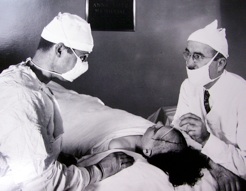
Freeman operating on a patient with his partner, James Watts

A diagram from Freeman's book (with Watts), Transorbital Lobotomy

When, at a lecture, Freeman was accused of callousness, the neurologist rebutted by showing a box of Christmas cards from his patients. The cards are still in Freeman's archives.
Walter Freeman and Lobotomy's Visual Archive
Walter Freeman (1895 – 1972) was a neurologist who pioneered and popularized lobotomy. In this procedure, the brain's frontal lobe is separated from the thalamus. The effects of lobotomy vary from patient to patient, but the procedure was designed to make aggressive mental patients less dangerous. Freeman thought that lobotomy had wider applications, and he administered lobotomies to patients suffering from depression and pain. All in all, Freeman performed more than 3,500 lobotomies, often as outpatient procedures.
My work on Freeman focuses on a less well-known aspect of his career. The neurologist was also an avid photographer, obsessively documenting his patients before and after their procedures. Freeman also made a series of films showing lobotomies and their effects. After he stopped performing lobotomies in the early 1960s, Freeman crossed the country in his van (nicknamed the Lobotomobile), tracking down former patients and snapping their photographs.
Resources on Lobotomy and Walter FreemanI've narrated a slideshow on Walter Freeman's photographs on NPR's Science Friday's Science and the Arts blog.
I've written more about the Freeman photographs on my blog.
Howard Dully, one of the last people on whom Freeman performed a lobotomy, has written a book and helped to produce a radio documentary about his own life.
A PBS documentary called The Lobotomist is a thorough and careful examination of Freeman's life and work.
The book on which the PBS documentary is based, Jack El-Hai's The Lobotomist, is sensitive and well-written.
The best scholarly work on lobotomy, Jack Pressman's Last Resort, shows how lobotomy came to be seen as the best option for overburdened mental hospitals. Elliot Valenstein's Great and Desperate Cures is also very good.
Here's a more extensive bibliography of works related to photography and the history of psychiatry.